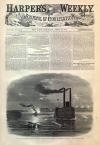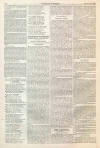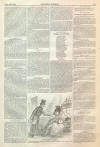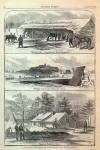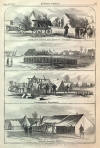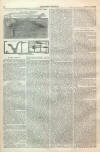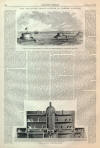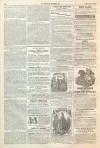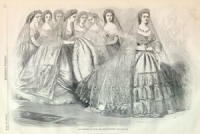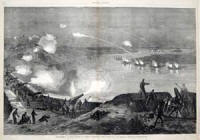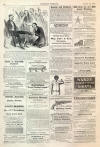Harbor Defense
|
|
This Site:
|
HARPER'S WEEKLY. [APRIL 18, 1863. 252 THE REVOLVING TOWER APPLIED TO HARBOR DEFENSE.CORDON OF REVOLVING TOWERS AND CHAINS FOR HARBOR DEFENSE, AS ARRANGED BY MR. TIMBY.THE question of Port and Harbor Defense is of the utmost importance at the present moment. These are the vital points at which we may be assailed by a maritime enemy. With the present means of destruction a single vessel of war once within range of a great city holds it at mercy. The first gun-boat which lay off the levee virtually captured New Orleans; and a single vessel of war in the North or East river could impose its own terms upon New York. Recent events show that ordinary forts are almost powerless to prevent the passage of steamers. The range of casemated guns is so narrow, and their aim is so uncertain, that the chances are that a passing steamer will not be struck. Our fleet passed Forts St. Philip and Jackson almost unharmed, and our Western gun-boats run with impunity the gauntlet of the miles of batteries at Vicksburg. Indeed, the power of our present fortifications, both offensive and defensive, is altogether inferior to that of the iron-clad vessels, with their heavy ordnance, to which they may be opposed. We must have a system of defense adapted to the present state of offensive warfare, and iron must be the material used. Captain Dahlgren, in his able Report, says: "Whatever may be the material of the interior structure, the exterior must be of iron. Bare masonry should never be exposed to the action of rifled cannon." This conclusion is strikingly verified by what has occurred within the few months since the date of this Report. The heavy guns of the Montauk, which brought down the solid rock of the Palisades by the rod, produced no perceptible effect upon the earth-works of Fort McAllister, whose huge balls also glanced like hailstones from the iron armor and turret of the vessel. The offensive power of our fortifications must also be largely increased to meet the new state of things. They must be enabled to concentrate a large fire upon any desired point. The demonstrated success of the principle of the Revolving Tower shows clearly how this is to be done. It is no derogation to the credit justly due to Mr. Ericsson to say that in his application of this principle he has availed himself of only a small part of its capability as proposed by its inventor, Mr. Theodore R. Timby. This gentleman, as was shown at length in an article in a late number of Harper's Magazine, invented the Revolving Tower more than twenty years ago, and secured a patent covering the entire principle of the "Revolving Tower for offensive and defensive warfare, whether used on land or water;" and every such turret is built under this patent, and the inventor is paid a royalty upon each. The principle, as developed by Mr. Timby, is indeed capable of still more effective application to stationary than to floating batteries. The illustration at the top of this page presents an external view of such a stationary tower, and the application of a cordon of them to the defense of the harbor of New York. The diagram at the bottom of the page exhibits the interior structure. The tower is supposed to be of iron, 100 feet in diameter, with 60 guns in two tiers, revolving once in a minute, by means of a steam-engine placed in the foundation upon which the tower rests. It can be of any required thickness. If one foot is not sufficient, it may be two or five, so as to be absolutely impregnable to the heaviest ordnance. The arrangement for sighting at. If this moves, he follows it, just as a sharp-shooter with his telescopic rifle follows the course of a moving object until he is ready to fire. Now, as the tower revolves around the turret each gun is at every revolution for an instant brought directly in a vertical line with the telescope, and if the gun were discharged at this instant the ball would go straight to its mark. Provision is made for doing this with unerring certainty, by means of a galvanic battery, with conducting wires leading to each gun, so arranged that the connection is formed at the instant when gun and telescope are in a line. A micrometer is attached to the telescope, by means of which the commander ascertains the precise distance of the enemy, and a signal to the officer of each gun directs him to elevate or depress the piece so as to secure the proper range. It will be seen that the gunners have nothing to do but to load their pieces, run them to the port-hole, and place the fuse in the vent. The aiming and discharging of the whole battery is done by one presiding mind calmly seated in the watch-tower. And as it has been abundantly shown that a gun can be loaded in one minute, the effective power of one such tower is 60 guns a minute—one every second—delivered with unfailing accuracy upon any point in the whole circle of the horizon within the range of the pieces. A moment's consideration will show that the precision of the aim of each gun in the battery is greater than that of a sharp-shooter with a telescopic rifle, for it does not depend at all upon the firmness of the hand of the marksman, but solely upon the accuracy of his sight and the coolness of his judgment. Moreover, there is an interval—brief it may be, but still an interval—required for pulling the trigger of the rifle; but in the case of the cannon, the discharge being effected by electricity, there is no space of time which we can measure between the aim and the discharge. If a shot from a cannon traveled with the same accuracy as does a rifle-bullet, a man might be picked off with a 15-inch ball as easily as with a rifle-bullet. This perfect accuracy of flight is perhaps not attainable; but assuming the extreme range of a cannon-ball to be two miles, there is no question that a ship could be hit at that distance by every shot. Having thus a clear idea of the offensive power of a single tower—that is, that it can deliver a shot every second upon any point within the range of its ordnance—we are prepared to consider the value of a cordon of these towers, in conjunction with various auxiliary appliances suggested by Mr. Timby, as designed for the defense of the harbor of New York, and with such modifications as their topography requires, for every other of our ports. The "Narrows" is of course the point of defense. This passage is about one-third of a mile wide. From each shore a dock is to be built, upon the extremity of which a tower will be placed, reducing the width of the channel to a quarter of a mile. Midway in the channel another tower will be erected upon an artificial foundation. A hostile vessel or fleet seeking to enter the harbor would thus be exposed at every rod of its advance, from the moment when it came within range, to the concentric fire of these three forts, amounting in all to three shots in a second, delivered with unfailing accuracy. As they came up, they would first receive the shots in their bows; when they came opposite the towers, the whole broadsides would be exposed. It is believed that nothing that ever floated could long survive such a fusilade; but if they should succeed in passing, then, as long as they were within range, their sterns would be exposed. But the plan, as developed by Mr. Timby, and illustrated in the engraving at the head of this page, makes provision for detaining the enemy right under the towers, and with broadside exposed, at point-blank range. A series of massive chains is to be stretched from fort to fort, attached to windlasses moved by the steam-engines in the towers. These chains during peace lie quietly at the bottom of the water, making no obstruction to the passage. But when the approach of an enemy renders it desirable to close the harbor, they are to be drawn up—not "taut," for in that case a great part of their strength would be exhausted in maintaining the tension; but they are to hang swaying in the water at such a height as to prevent the passage of the enemy's vessel. Still further to reduce the strain upon the chains occasioned by their weight, it is proposed to attach to them metallic buoys, leaving their dead weight just sufficient to sink than to the bottom, and causing hardly any strain. Such a cordon of chains would effectually stop the most powerful steamer afloat, leaving her most vulnerable points exposed at short range to a fire of two guns in a second, delivered with perfect accuracy. No vessel ever yet built, capable of navigating the open seas, and thus to be brought to the attack of the harbor of New York, could, we believe, sustain such a fire for a quarter of an hour. It may be still a matter of doubt whether vessels of our "Monitor" class, with scarcely a point vulnerable to shot, could endure it. Nothing can be more certain than that the ponderous mailed ships built by France and England would go down in a few moments under the fire of these towers while detained by the cordon of chains. But to guard against the possible passage of vessels like our "Monitors," whose vulnerable point lies under water, and is thus safe from cannon-shot, Mr. Timby proposes to add a series of "torpedos" affixed to a chain running from tower to tower in such a manner that they may be drawn directly under a vessel as it lies detained by the chains; these can be discharged at any instant by means of the Galvanic battery, thus with almost unfailing certainty blowing the enemy out of the water. These are the main features of the "System of Revolving Towers as applied to Harbor Defense," as elaborated by the inventor of the principle of the revolving tower. To us they seem fully adequate to insuring an absolutely perfect defense of all our great harbors against any possible assault from the combined navies of the world. Of course to them might be added, if need were, any further auxiliaries, such as floating batteries and rams. It will be observed that there is not a principle involved in this plan which has not now been thoroughly tested by actual trial. We know that towers have been built capable of resisting any guns now known, and that their defensive power can be increased to any required extent. We know that the revolution of these towers can be effected. We know that guns can be instantaneously discharged by the means of the Galvanic battery, and that guns of any size can be fired from the interior of a tower. Thus all the elements involved in this scheme are of well-known and established character; and they are so combined as to bring the most powerful forces known to us under the absolute control of a single mind, which directs the whole toward a single desired result. It must be borne in mind that the defensive powers of these towers is even greater than their offensive powers. That they may be made proof against any guns that have been or can be constructed is clear. Still more evident is it that they would be unassailable by direct assault or escalade. If cannon-balls could not penetrate them, human beings could not. They could only be reduced by famine. The cost of guarding our harbors by such a cordon of towers would of course be considerable. But a mere inspection of the general features of the plan is quite sufficient to show that it would be less than by the present mode of stationary forts. And no matter what were the cost, if the end in view were attained it would be well laid out. The one end is to render our great sea-ports absolutely safe from assault by a hostile naval power. A single armed steamer once fairly within range of New York or Boston, or Philadelphia or San Francisco, could in an hour cost us more than would be required to build all the towers and appliances required for their perfect defense. Nothing can be more clear than that a cordon of these towers will cost less in time and money than the miles of earth-work and batteries with which the Confederates have endeavored to bar the passage of the Mississippi at Port Hudson and Vicksburg, all of which are shown by trial to be absolutely inadequate to prevent the passage by a hostile fleet, even of unarmored vessels. Whether the stationary defenses of Charleston and Savannah are adequate to defend these ports from iron-clad vessels is, as we write, a matter of doubt. In any case, however, we are confident that the Revolving Turrets furnish, at a small proportion of original cost, a far more efficient mode of defense than any which is possible by the existing systems of defense. It concentrates at any given moment a greater amount of fire upon any point, delivered with far more accuracy, than has been hitherto attempted. It must also be borne in mind that the cost in men and money is greatly diminished. Miles of fortifications demand thousands of men. A Revolving Tower will require only men enough to work the guns and manage the engines. and discharging the guns, which is not embodied in the "Monitor" turrets, is really the most important part of the whole invention. This will be clearly understood from the sectional diagram, which represents the tower cut down vertically through the centre, so as to show the interior arrangements. In the centre, under the dome-shaped roof, is a small turret, which is the commander's station during action. This rests upon a central shaft, which revolves in either direction, independent of the tower itself, by means of a wheel and gearing, under the control of the commander, and not by means of the steam-engine. There is in the roof a narrow opening, through which, by means of a theodolite, or telescope, the commander keeps watch of the enemy. By turning the turret in either direction he keeps the telescope always pointed directly toward the object aimed VERTICAL SECTION OF REVOLVING TOWER.A, A, Exterior and interior walls of the Tower, with dome-shaped roof, K, revolving by the gearing F, upon the friction rollers, G, G.—C, C, Artillery Platforms, with guns mounted upon their carriages, which radiate from the common centre.—B, The Central Turret, revolving, independently of the Tower, upon the shaft b, b, by means of the rod and gearing, D; on the left of the shaft is seen the circuit-closer, forming; the connection between the galvanic battery and the conducting chains passing to each gun.—E, E, E, Ventilators.—H, H, Casemates, with guns, independent of the Revolving Tower.—I, I, Wells of subterraneous foundation for the Tower, forming chambers for stores and munitions. 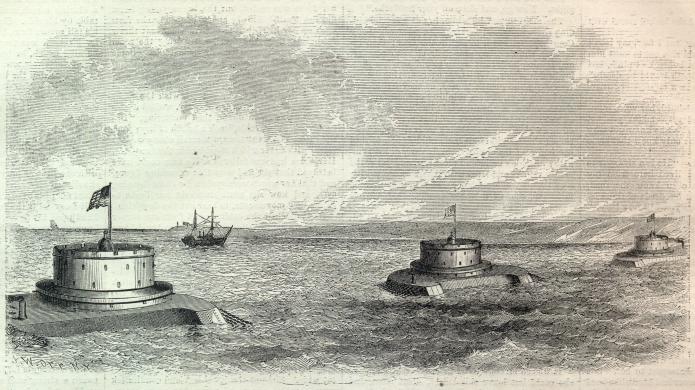 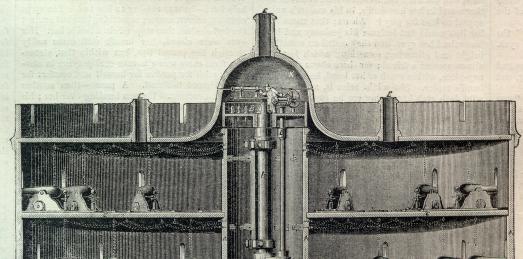  |
||||||||||||||||||||||
|
|
||
|
|
Site Copyright 2003-2018 Son of the South. For Questions or comments about this collection, contact paul@sonofthesouth.net |
|
|
Are you Scared and Confused? Read My Snake Story, a story of hope and encouragement, to help you face your fears. |
||
